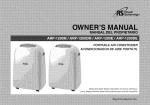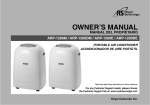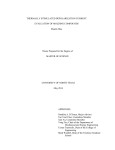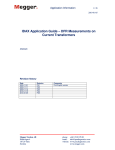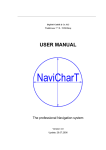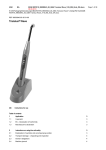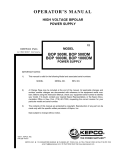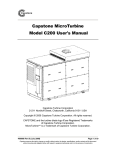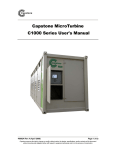Download Studhorse1200DM manual US&CE 2009-1 - Red-D
Transcript
STUDHORSE 1200DM STUDHORSE 1000DM P/N 101201- 1200 Amp Drawn Arc Stud Welder P/N 101001- 1000 Amp Drawn Arc Stud Welder OPERATING MANUAL REVISED DECEMBER 2009 2203 Northwood Drive, Unit 10 Salisbury, MD 21801 Tel: 410 572.6000 Fax: 410 572.6027 [email protected] www.arconweld.com Declaration of Conformity Manufacturer’s Name: ARCON Welding Equipment, LLC Manufacturer’s Address: 2203 Northwood Drive, Unit 10 Salisbury, Maryland 21801 USA Declares that the product: Product Name: Studhorse 1200DM Studhorse 1000DM Model Number 101201-xxx 101001-xxx Conforms to the following standards: Underwriters Laboratories Standard UL551 Safety: EN 60974-1 2002 Degree of Enclosure Protection IP 24 in accordance with ISO 60529 This product is in conformity with the requirements of the Low-Voltage Directive (73/23/EEC) and Machinery directive 89/392/EEC, 91/368/EEC, 93C 133/04, 93/68/EEC. Compliance Certified by: Goran Hedberg, Design Engineer Technical Contact: Mike Bell, Product Engineering ARCON Welding Equipment LLC 2203 Northwood Drive, Unit 10 Salisbury, Maryland 21801 Fax: 410-572-6027 Email: [email protected] For further details please contact the factory: ARCON Welding Equipment LLC 2203 Northwood Drive, #10 Salisbury, Maryland 21801 USA Tel: 410-572-6000 Toll Free: 888-512-7266 Fax: 410-572-6027 Email: [email protected] [email protected] www.arconweld.com 2 Studhorse Operations and Service Manual TABLE OF CONTENTS GENERAL INFORMATION User Responsibility Limited Warranty Safety Standards Corrosion Protection 5 5 5 6 1.1 Safety Symbols 1.2 Safety Precautions 1.3 Electric Shock Can Injure or Kill 1.4 Arc Rays Can Injure Eyes and Burn Skin 1.5 Fumes and Oxygen Depletion Can Be Dangerous to Your Health 1.6 Welding Sparks Can Cause Fire and Explosion 1.7 Electric and Magnetic Fields May be Dangerous 1.8 Protect Yourself and Others 7 7 7 8 8 9 9 9 10 1. SAFETY 2. PRODUCT DESCRIPTION & INFORMATION 2.1 Introduction to The Studhorse 1200 DM and 1000DM 2.2 Product Specifications 2.3 Safety Standards 3. INSTALLATION 3.1 Handling and Unpacking the Welder 3.2 Selecting a Location 3.3 Selecting Suitable Supply Cables 3.4 Connecting Input Power 3.5 Fuse and Circuit Breaker Ratings 3.6 Output Connections and Stud Gun Selection 3.7 Stud Guns 10 10 11 11 11 12 12 12 12 13 13 13 4. OPERATION 4.1 General Description 4.2 Design Features 4.3 Operational Controls and Settings 4.3.1 Circuit Breaker (Power on/Off) 4.3.2 Digital Meter on The Studhorse 1200DM/1000DM Models 4.3.3 Setting the Welding Current & Time 4.3.4 Process for various Stud Welding Positions 4.3.5 Process Control Selection (Figure 4.1) 4.4 Welding Operation 4.4.1 Begin welding utilizing Factory suggested Weld Setpoints 4.4.2 Digital Timer and Setting Operation for the Studhorse 1200DM/1000DM 4.4.3 Discharging the Current after a dry fire (the Stud does not weld) 4.4.4 Five-Zones Thermal Protection Control 14 14 14 14 15 15 15 16 17 17 17 18 18 3 5. VISUAL INSPECTION 5.1 Visually inspection welded Studs 19 6. MAINTENANCE AND REPAIR 24 7. TROUBLESHOOTING GUIDE 25 8. ELECTRICAL SPECIFICATIONS & DIAGRAMS 27 28 29 30 31 32 33 34 8.1 8.2 8.3 8.4 8.5 8.6 8.7 The principles of the inverter design (Figure 8.1) Main Circuit Diagram Front Panel Drawing with part references Rear Panel Drawing with part references Chassis Plate Drawing 1 with part references Chassis Plate Drawing 2 with part references Inductor Plate Drawing with part references 9. PARTS AND ACCESSORIES 9.1 Replacement Parts 9.2 Accessories 35 37 4 GENERAL INFORMATION User Responsibility ARCON Welding warrants that The Studhorse 1200DM & Studhorse 1000DM will perform in accordance with the product description in this manual. The Factory Warranty will be null and void should the user attempt to operate The Studhorse after it has malfunctioned. Parts that are broken, missing or worn must be replaced immediately. ARCON Welding Equipment LLC or its Authorized Repair Center will perform warranty Repairs. The Studhorse or any of its parts must not be altered without the prior written approval of ARCON Welding Equipment LLC. Any malfunction resulting from improper use, faulty maintenance, physical damage, unapproved repair or alteration, shall be the sole responsibility of the user or owner. Any repair to improperly used or abused equipment by ARCON Welding Equipment LLC will be charged based on ARCON’s applicable hourly labor rate and current replacement part prices. Manufacturer’s Limited Product Warranty ARCON Welding Equipment’s only warranty is that goods being sold will be free from defects in materials and workmanship. This express warranty is in lieu of any other warranties, either expressed or implied, and whether statutory or otherwise, including any implied warranty of merchantability or fitness for a particular purpose. The Manufacturer’s written warranty for The Studhorse 1200DM & Studhorse 1000DM Welders has been included with your new machine, and is limited to defect in materials or workmanship. The original purchaser must furnish notice of defect or failure to ARCON Welding Equipment or one of Arcon’s authorized repair centers using an approved Warranty Claim Form. Forms can be downloaded from the company Web Site at http://www.arconweld.com. The guarantee against corrosion-related failures can be extended to five-years by completing the Registration Form. Any equipment that has been modified by any party other than ARCON Welding Equipment LLC, or equipment that has been improperly installed, improperly operated, misused based upon industry standards, improperly maintained or equipment which has been used for operation outside of specifications will not be covered under the manufacturer’s warranty. ARCON Welding Equipment shall in no way be liable for any consequential damages. ARCON Welding Equipment reserves the right to make engineering and/or part changes at any time, without notice, as improvements in quality or design are made. Owners and operators of The Studhorse 1200DM & Studhorse 1000DM should access the company Web site listed above to keep up-to-date with offerings, applications and technical suggestions. SAFETY STANDARDS The Studhorse 1200DM & Studhorse 1000DM are designed and built to comply with the following safety standards: Underwriters Laboratories Standard UL551 Safety EN 60974-1 Degree of Enclosure Protection IP 24 in accordance with ISO 60529 • Protection against full penetration of solid foreign objects of 12.5mm diameter and larger. • Protection against harmful effects from splashing water against the enclosure from any direction. Please review all safety infomation in Section 1 very carefully before operating the machine. 5 This machine is protected against corrosion ARCON’s time-proven Seahorse manufacturing process protects electrical components prone to failure from corrosion by design and using a compound containing cycloaliphatic-epoxides, tetramethylen-oxide and a cationic photoinitiator (commonly called conformal coating). This protection is incorporated as certain electrical components and printed circuit boards are produced to ensure excellent weathering and superior protection against humidity, moisture, dust, fungus and other contaminants. The Seahorse process used in this machine was developed and tested on oilrigs in the North Sea decades ago. This protection enhances reliability, prolongs component life and adds value to all of ARCON’s rugged line of portable welding power sources. Listed below are some of the steps ARCON Welding has taken to increase corrosive atmosphere resistance in this machine: Transformer Auxiliary transformer Output board Control board Input board Resistors Fan motor Terminal screws vacuum impregnated twice and dipped an additional time. protected and coated to resist corrosion. encapsulated in *repair-friendly material to eliminate the failures. coated to protect against salt-water arc over. coated to protect components from corrosion. replaced with porcelain-coated ceramic resistors. totally encapsulated winding coil to withstand corrosive conditions. coated to prevent electrical arc-overs. This anti-corrosion process comes with ARCON’s five-year manufacturer’s guarantee against corrosion-related electrical failure within natural operating environments. This warranty begins the day the machine was shipped from the factory and does not apply to equipment used in man-made environments that produce chemical residue, dust or airborne debris of man-made substances, etc. Because the Seahorse protection is incorporated in the manufacturing process, any circuit modifications, repairs or component replacement with non-ARCON parts will void the Seahorse guarantee. Repair centers should contact the factory to obtain replacement parts for this machine. Customers that intend to submit a warranty request for corrosion related failure should contact the factory to obtain an RMA number before shipping their welder to the factory for evaluation. 6 1. SAFETY Safety is eveyone’s responsibility. ARCON designs every machine with safety in mind, and a safe work environment depends largely on you. Do not install, operate, or repair this equipment without carefully reading this manual and observing all of the safety precautions mentioned. If there is a question, ask your supervisor! 1.1 Safety Symbols Every effort has been made to protect trained operators from injury or unnecessary risk. Certain symbols are used throughout this manual to call attention to safety-related information and instruction. The safety symbols in this manual have the following meanings: This symbol indicates Dangerous Situations. When this symbol is used in this manual, death or serious bodily harm is possible or probable if the corresponding preventative measures are not taken. Operators must take caution in the method and manner of handling or using the machine when this symbol is displayed. 1.2 Safety Precautions Do not install, operate, or repair The Studhorse welding equipment without reading this manual and all safety precautions stated within! This machine was designed and built with operator safety in mind, but safety begins with you! Every effort has been made to protect the trained operator from injury. Please become familiar with the information in this manual to minimize the risk of shock or injury. STUD WELDING CAN BE HAZARDOUS. ALWAYS PROTECT YOURSELF AND OTHERS FROM POSSIBLE INJURY OR DEATH. KEEP CHILDREN AWAY. OPERATORS WHO WEAR A PACEMAKER SHOULD CONSULT WITH THEIR PHYSICIAN BEFORE OPERATING STUD WELDING EQUIPMENT. THIS OPERATOR’S MANUAL SHOULD ALWAYS BE KEPT WITH THE STUDHORSE MACHINE FOR QUICK REFERENCE. ALL SAFETY WARNINGS, SIGNS AND STICKERS MUST STAY ATTACHED TO THE MACHINE. ALL OPERATORS MUST BE PROPERLY TRAINED AND PROTECTED BEFORE OPERATING THIS EQUIPMENT. 7 1.3 ELECTRIC SHOCK Precautionary measures must be taken to provide maximum protection against electrical shock. Electric shock can injure or Kill! WARNING 1. 2. 3. 4. 5. Do not touch live or energized electrical parts or store metallic objects near power. Ground the work or metal to be welded to a good electrical (earth) ground. Do not leave an energized machine unattended. Never work in wet clothing, gloves or footwear. Insulate yourself from work and ground using dry insulation. Make certain the insulation is large enough to cover your full area of physical contact with work and ground. 6. Inspect all system components, protective equipment, cables, connectors and gas lines prior to operating equipment. Never use cables that are longer than necessary. 7. When testing a live unit, use the one-hand method. Do not put both hands inside of the unit. Keep one hand free. 8. Disconnect input power conductors from de-energized supply line before moving a welding power source. 9. Always be sure the work cable makes a good electrical connection with the metal being welded. The connection should be as close as possible to the area being welded. 10. Turn OFF welding power source before servicing unless the procedure specifically requires an energized unit. 11. Never touch the energized stud or gun before discharging the stud to ground. 12. Never use the power source to provide heat for thawing frozen pipes. 1.4 ARC RAYS and EYE PROTECTION Arc rays can injure eyes and burn skin. Arc flashes are painful. 1. Use a shield with the proper filter and cover plates to protect your eyes from sparks and the rays of the arc when welding or while observing open arc welding. 2. Use protective clothing specifically intended for work with welding equipment. It should be made of durable flame-resistant material to provide ample protection from the arc rays. 3. Protect other nearby workers with suitable, non-flammable screening. Caution other workers not to watch the arc nor expose themselves to the arc rays or to hot spatter or metal. 8 1.5 FUMES and OXYGEN DEPLETION Only weld in areas or rooms where adequate ventilation of weld gases is possible, and where there are not fire, smoke or explosion hazards. 1. When working in a confined space always have trained support personnel nearby. 3 4 1.6 Welding fumes and gases can displace air and lower the oxygen level causing injury or death. Be sure the breathing air is safe. Do not weld in locations near degreasing, cleaning, or spraying operations. The heat and rays of the arcs can react with vapors to form highly toxic and irritating gases. Do not weld on coated metals, such as galvanized, lead, or cadmium plated steel. The coating must be removed from the area to be welded. Coatings and metals containing above elements can generate toxic fumes when heated to welding temperature. WELDING SPARKS Heat from flames and arcs can start fires. Hot slag or sparks can also cause fires and explosions. 1. Remove all combustible materials from the work area or cover these materials with a protective non-flammable tarp. Combustible materials include wood, fabrics, sawdust, liquid and gas fuels, solvents, paints and coatings, paper, etc. 2. Hot sparks or hot metal can fall through cracks or crevices in floors or wall openings and cause a hidden smoldering fire. Make certain that such openings are protected from hot sparks and metal. 1.7 ELECTRIC AND MAGNETIC FIELDS Electric current flowing through any conductor causes localized Electro-Magnetic Fields (EMF). Welding and cutting current creates EMF around welding cables and welding machines. 1. Operators having pacemakers should consult their physician before welding. EMF may interfere with some type of pacemakers. 2. Exposure to EMF may have other health effects, which are unknown. 3. Operators should use the following procedures to minimize exposure to EMF: a. Route the work cables together. Secure them with electrical tape when possible. b. Never coil the work cable around any part of your body. c. Do not place your body between the work cables. Route cables on the same side of your body. d. Connect the work cable to the work piece as close as possible to the area being welded. e. Keep welding power source and cables as far away from your body as possible. 4. Electromagnetic fields can permanently erase magnetic data carriers (computer memory, credit cards, security ID cards or data storage diskettes). 5. Electromagnetic fields may magnetize and damage watches or similar digital devices. 9 1.8 PROTECT YOURSELF AND OTHERS! Some welding, cutting, and gouging processes are noisy and require ear protection. The arc, like the sun, emits ultraviolet (UV) and other radiation and may injure skin and eyes. Hot metal can cause burns. Training in the proper use of welding processes and equipment is essential to prevent accidents. 1. Always wear safety glasses with side shields in any work area. In conjunction with eye protection, welding helmets or face shields are also required. 2. Use a face shield fitted with the correct filter cover plates to protect your eyes, face, neck, and ears from sparks and rays of the arc when operating or observing operations. Warn bystanders not to watch the arc and not to expose themselves to the rays of the electric arc or hot metal. 3. Wear flameproof type gloves, heavy long-sleeve shirt, cuff less trousers, and a welding helmet or cap for hair protection, to protect against arc rays and hot sparks or hot metal. A flameproof apron may also be desirable as protection against radiated heat and sparks. 4. Hot sparks or metal can lodge in rolled up sleeves, trouser cuffs, or pockets. Sleeves and collars should be kept buttoned, and open pockets eliminated from the front of clothing. 2. PRODUCT DESCRIPTION AND INFORMATION 2.1 INTRODUCTION TO THE STUDHORSE 1200DM & STUDHORSE 1000DM The Studhorse 1200DM and 1000DM machines are portable drawn arc Stud welders using an inverter-type power supply to generate the output power. Both machines are currently available in the following models: 400V three-phase or 480V three-phase. 10 2.2 Model PRODUCT SPECIFICATIONS Stud Welding Current Welding Range (Amps) 1200A @ 6% 3001200 Open Circuit Voltage Input Amperes at Rated Load Output* (50/60 Hz) 400V 1200DM KW Physical Efficiency Dimensions Net 1000A @ 6% 3001000 Ship 480V Height: 17.9” 45.5cm 80 Max 1000DM Weight 8V w/ LOCV 35 ±10% 30 ±10% 23.8 ±20% 79.60% Approx. Approx. Width: 10.5” 80lbs. 90lbs. 26.7cm 36.3 kg. 41.0kg. Depth: 19.5” 49.5cm 400V or 480V three-phase * Slow Blow Fuse *The three-phase supply voltage is connected to a circuit breaker and then to a six-pulse rectifier circuitry and a radio noise suppression module. The AC voltage is connected to a step-down transformer to power the welder. The AC welding voltage is first rectified to create a DC welding current. The control logic measures the welding voltage and welding current. It also makes the inverter create the suitable welding characteristics. The auxiliary transformer steps down the input voltage to 48V center tapped. This transformer powers the cooling fan and the control logic. 2.3 SAFETY STANDARDS The Studhorse 1200DM & Studhorse 1000DM are designed and manufactured to comply with the following safety standards: Underwriters Laboratories Standard UL551 Safety EN 60974-1 Degree of Enclosure Protection IP 24 in accordance with ISO 60529 • Protection against full penetration of solid foreign objects of 12.5mm diameter and larger. • Protection against harmful effects from splashing water against the enclosure from any direction. 3. INSTALLATION WARNING! • Only qualified personnel should perform this installation. • Turn the input power off at the disconnect switch or fuse box before working on The Studhorse. • Do not touch electrically hot parts. 11 This section provides detailed instructions for the proper installation of The Studhorse. It is recommended that these instructions be followed carefully to allow for the best possible operating environment. 3.1 Handling and Unpacking the Welder Since The Studhorse 1200DM & Studhorse 1000DM machines weigh approximately 90 pounds in the shipping carton, no fork lift or crane is necessary to move the machine. The shipping carton has built-in reinforced handles to enable two people to easily transport the machine. Immediately upon receipt of the welder, inspect the shipping box for any damage and notify the carrier of such damage before accepting delivery. Then inspect The Studhorse for damage which may have occurred in transit. After removing the components from the shipping container(s), check the container for any loose parts. Remove all packing materials. Visually check all air passages of power source for any packing materials that may obstruct airflow through the welder. If the equipment is not being installed immediately, store it in a clean, dry, well-ventilated area until installation. 3.2 Selecting a Location The location of the power source should be carefully selected to ensure satisfactory and dependable service. Choose a location relatively close to a properly fused source of electrical power. Use care against toppling over if the machine is placed on a tilted surface or plane. It is important that the machine be located in an open area where air can circulate freely through the front and rear openings. If space is at a premium, leave at least 1 foot (300 mm) of clearance between the rear of the power source and wall or other obstruction. 3.3 Selecting Suitable Supply Cables The standard power input cable for The Studhorse 1200DM and 1000DM welder is a high quality #10 Gauge cable that is 12.5 feet long. The secondary cables that connect the Stud gun to the power source vary with manufacturers, but is normally 1/0 gauge and 8 feet in length. Heavier 2/0 gauge cables can be used to extend the distance between the machine and work surface. Standard ground cables are 1/0 gauge with 25 feet maximum length. Cable lengths can total 50 feet (total primary length plus total secondary length) using heavier 2/0 cables. WARNING! • • • Only qualified personnel should perform this installation. Turn the input power off at the disconnect switch or fuse box before working on The Studhorse. Do not touch electrically hot parts. 12 3.4 Connecting input power The standard factory installed input power cable measures 12.5 ft. A longer power cable may have been provided as an option if requested. The primary cable supplied with the power source has 4 conductors. When connecting an attachment plug or hard wiring to an electrical service box, connect the green/yellow wire to the ground. The remaining 3 conductors can be connected to the phases in any order. Once connected to the primary power, the power source must be turned OFF before the unit is moved. 3.5 Fuses and Circuit Breakers It is recommended that input fuse sizes be in accordance with the table below: Input Voltage 400V 460V-480V Welder input Maximum Amperage 24 20 Recommended Fuse Capacity 30A Time Delay (Slo-Blow) 30A Time Delay (Slo-Blow) Table 2.0 3.6 Output cable connections The standard supplied output connectors on the rear panel are female Cam-Lok type. Welders may have been supplied with Tweco type or Dinse (DIX) type if special ordered. Certain adapters for connection to welding cables can be supplied as an option. Maximum recommended length is 50 feet 2/0 total gun and ground cable. 3.7 Stud Guns There are several manufacturers of Stud welding guns. A Stud gun is shaped to fit in the hand, in the shape of a handgun, and is a semi-automatic stud welding tool. Guns vary in design, connection, weight, capacity and Duty Cycle. Only guns suitable for drawn arc Stud welding can be used and are available for Short Cycle, Standard Duty and Heavy-Duty use. The pin configuration of the gun must be compatible with The Studhorse 1200DM and 1000DM. Units come standard with a 4-pin panel mounted control connector for the firing gun. The pistol grip switch initiates the stud current through the welding cables and, at the same time, powers the solenoid in the gun so that it retracts. Attach the gun cable to the (-) jack on the power supply and attach the ground clamp to the (+) jack on the power supply. There is very little to do when unpacking the Stud Welding gun. The gun should be complete with all the tools and accessories required for setup, adjustment and maintenance. Guns should be equipped with the correct chuck, ferrule grip and special accessories for each application. Operators should consult the Operation/Maintenance Manual from the Stud Gun manufacturer for complete instructions for safe operation and maintenance. 13 4. OPERATION WARNING! PLEASE READ CHAPTER 1 REGARDING SAFETY 4.1 General Description The Studhorse power source combines time-proven technology with modern technology to provide high-quality performance. The digitally controlled SCR type inverter is very reliable in welding applications and capable of welding full-base weld studs in a variety of applications. 30 Amp Slo-Blow fuses provide protection for 400V and 480V input models.. 4.2 Design Features The Studhorse power source is designed to be portable and easily transported to provide many benefits. No crane or special lifting devices are required to move or maintain the machine. The machine provides Constant Power output with Inverter-smooth arc, incorporating digitally controlled start/stop. Other features include regulated output, step-less weld power and time adjustment, short-circuit protection, automatic line voltage protection and 5-zones of thermal protection. 4.3 Operational Controls and Settings – also refer to Figure 4.1 4.3.1 Circuit Breaker (Power On/Off) The Circuit Breaker serves as the main input power switch and located on the control panel at the rear of the machine. Move the switch lever up to the ON position to start the machine. The Power-On indicator light will show that input power is being supplied to the machine. 4.3.2 Digital Meter on The Studhorse 1000DM & 1200DM models The digital current and timer meter displays current when the push button toggle switch is pushed once, and displays time when pushed in again. After switching on the input power to the machine, the four-digit display shows the operational mode PA. The display shows the actual Current for three seconds after each Stud has been welded. The Current setting is displayed as ”(X)XXX” and actual Current is displayed as ”(X)XXX”. If display flashes, the machine has exceeded its temperature limits. Wait until the machine has cooled (may take up to 4 minutes), indicated by the the display no longer flashing, and then resume welding. 14 4.3.3 Setting the Welding Current and Time Pressing the push-button switch on the front panel toggles the display presentation between Current and Time. There are separate (potentiometer) controls for setting the Current and the Time. When the current value is set and a stud is welded, the actual current delivered (measured value) is displayed for 3 seconds after completion of the stud. Thereafter, the set value is displayed again. The measured current may fluctuate up to 5 % dependent on the angle of the stud and the surface on which the weld is performed. Typical variations from stud to stud may be a low as 1%. The Stud Time can be set from 0.05 seconds to 1.00 second with 0.01 second accuracy in .01 second increments using the Time control knob. 4.3.4 Process for various Stud welding positions Drawn Arc Stud Welding allows welding 1/4” to 3/4” diameter Studs made of non-alloyed, alloyed, stainless and heat-resistant steels to suitable base materials. The following is a guide for welding positions using The Studhorse 1000DM and 1200DM machines: Stud Welding Process Stud Diameter Minimum Plate Thickness Welding Position With a Ceramic Ferrule 1/4” to 3/4” One (1/4”) Quarter Inch Horizontal Vertical Overhead Using Inert Gas 1/4 to 1/2” One (1/4”) Quarter Inch Horizontal Only Short Cycle Less than 1/2” 16 Gauge Horizontal Vertical Overhead 15 4.3.5 Process Control Selection DIGITAL CURRENT & TIMER METER 4.3.2 POWER ON INDICATOR 4.3.1 4.4.4 CIRCUIT BREAKER (POWER ON/OFF) 4.3.1 STUD TIMER CONTROL 4.3.3 4.4.1 WELDING CURRENT CONTROL 4.3.3 4.4.1 GUN CONTROL CONNECTOR 3.7 INPUT POWER CORD 12 FT (3.65m) LONG 3.4 OUTPUT TERMINALS 3.6 FIGURE 4.1 4.4 Welding Operation 1. All secondary outputs must be connected to output terminals of the power source 2. After the primary input connections have been made, close the main wall disconnect switch or circuit breaker. 3. Set the primary power selector to the ON position. This will turn on the control circuitry. The Power-On light on the front panel will be lit. 4. Adjust the Welding Current Control and the Stud Timer Control to fit the type and diameter of weld stud to be used, according to the table in section 4.4.1. 16 4.4.1 Factory Suggested Weld Set points Stud Size Inches Recommended Current and Time Settings Current Metric (Amps) Time (Seconds) 1/4 (6mm) 450A 0.20 5 /16 (8mm) 550A 0.25 3/8 (10mm) 650A 0.35 1/2 (12mm) 850A 0.55 5/8* (16mm) 1000A 0.90 5/8 (16mm) 1200A 0.70 3 / 4 ** (19mm) 1200A 1.00 * Maximum for 1000DM model. ** Maximum for 1200DM model. Example: 1. If 1/2-inch studs are to be welded, set the current to 850 Amps and the time setting to 0.55 Seconds. 2. Shoot (weld) stud. 4.4.2 Digital Time and Setting Operation Depending on the length of your welding and gun cables, the measured current may vary. The measured current will be displayed on the current display for 3 seconds. After 3 seconds, the set value will be displayed again. The time and current settings will vary with the gun’s lift and plunge settings. A good weld is characterized by an even ”collar” formation, a shiny, bluish tint to the collar surface, a slight flow of collar metal into the base material, good collar height, consistant stud length after the weld and a full circle collar around the stud circumfirence after the weld. 17 4.4.3 Discharging the Current after a test fire (the Stud is not welded) WARNING – ELECTRIC SHOCK CAN INJURE OR KILL! The gun and ground circuits are electrically charged or ”hot” when The Studhorse is switched on and the gun trigger is depressed. Do not touch these ”hot” parts with bare skin or wet clothing before the discharging to ground. The electrical charge in live in the gun for approximately 20 seconds after the trigger is pulled on a ”dry fire”. Water, moisture and human skin are electrical conductors and complete an electrical circuit to ground (earth) allowing current to easily flow. Never weld in wet clothing, gloves or footwear. Always protect yourself from electricity using dry insulation Never leave an energized machine unattended and always check the condition of cables, connections and protective gear. Always keep one hand free when testing an energized machine and unplug equipment before cleaning or servicing. Please review and follow all safety precautions in this manual before using the equipment. 4.4.4 Responding to the 5 Zones Thermal Protection Control The display will begin blinking if any component is overheating. The operator must stop welding studs and allow the power source to cool down. This may take 3 minutes or more depending on which component is overheated. The following components monitor the internal temperature in The Studhorse welder: The 5 Zones of termal protection are incorporated to protect the machine from over temperature and extend the useful life of the machine. The feature also reduces the risk of costly repairs. The following zones are protected in your Studhorse power source: Main Transformer If overheating occurs, wait 1 minute before restarting. Main Inductor If overheating occurs, wait 7-8 minutes before restarting. Output Capacitor The Output Capacitor may overheat and shut down the welder. If this occurs, wait 10 minutes before restarting. The temperature sensor will protect the output capacitor. Input Capacitor: Should one phase be lost when welding with three-phase input power, current to the Input Capacitor could increase causing it to potentially overheat or be destroyed. Wait 10 minutes before restarting the welder. Fan Motor: Some operation with restricted airflow will overheat the fan motor. Wait 10 minutes before restarting the welder. 18 5. VISUAL INSPECTION 5.1 Visually Inspecting Welded Studs Use this guide to visually inspect welded studs to determine the quality of weld. The correct relationship between the Lift, Plunge, Time and Current is essential in order to obtain good weld results. Operators should used this guide to help interpret the appearance of the weld collar. 19 5.1 Visually Inspecting Welded Studs (continued) 20 5.1 Visually Inspecting Welded Studs (continued) 21 5.1 Visually Inspecting Welded Studs (continued) 22 5.1 Visually Inspecting Welded Studs (continued) 23 6. MAINTENANCE & REPAIR WARNING! Please see Chapter 1 regarding Safety • • • • • • Turn the input power OFF before working on any ARCON stud welder. Do not touch electrically live parts or electrode with your skin or wet clothing Insulate yourself from work and ground Always wear dry insulating gloves Have an electrician install the ARCON stud welder. An authorized ARCON Service Center must do all maintenance and repairs that require opening the case. If The Studhorse does not operate properly, stop work immediately and investigate the cause of the malfunction. Please note: Opening up the case voids the Warranty. Maintenance and repair should only be performed by an authorized ARCON Service Center, or by the factory. Do not permit untrained persons to inspect, clean, or repair The Studhorse. Please call the factory for the location of the Authorized ARCON Service Center nearest you. Since there are no moving parts other than the fan in the power source, basic preventive maintenance only involves keeping the welder clean and free from metallic dust. Periodically, you should ask your Authorized Service Center to remove the cover from the case, remove accumulated dust and dirt from the air passages and the interior components, using clean lowpressure air. It is imperative that the air passages to the interior of the unit be free of dirt to ensure adequate circulation of cooling air, especially over the rectifier bridge plates. The frequency of cleaning will depend on the location of the unit, the amount of dust in the atmosphere and number of operating hours. Operators are encouraged to check the following to maintain The Studhorse power supply: 1. Visually inspect the case, panels, handles and cables for damage, which may occur in transit and in normal use. 2. Check the machine for any loose or damaged parts. 3. Check air passages of power source for any debris that may obstruct airflow through the welder. 4. Monitor and schedule having the machine cleaned with compressed air by an authorized service center. 24 7. TROUBLE SHOOTING GUIDE WARNING – PLEASE OBSERVE ALL SAFETY PRECAUTIONS TROUBLE A. Fan rotates, no welding current. PROBABLE CAUSE 1. Gun Remote Cable not plugged in 2. Gun Remote Cable is defective. 3. Trigger was pulled within 6 seconds of last weld. A2. Unit shut down while welding, fan runs, display flashing 1. Overheated because: a) duty cycle was exceeded b) inadequate flow of cooling air. REMEDY 1. Plug in Gun Remote Cable and recheck unit. 2. Try a different gun (possible problem with gun trigger, for example) 3. Wait 15 seconds before shooting next stud 1a. Allow unit to cool for 10 minutes, reduce duty cycle. 1b. Make sure that intake and exhaust vents are not blocked. (In heavy dust areas clean unit out once per month with compressed air). 1.Over voltage or spikes 1.Reset breaker. 2. Incorrect voltage 3. Defective component 2. Hook to correct voltage 3. Call Factory or Authorized Service Center C. Fan rotates slowly 1. Incorrect input voltage to stud welder 2. Missing one phase 1. Ensure correct input voltage to stud welder 2. Correct input power D. Reduced output 1. One phase of 3 primary input missing 2. Incorrect cable length gauge setup. 1. Correct incoming power B. Circuit breaker trips E. Unit has no O.C.V. or output 1. Gun trigger not pulled to initiate welding current 2. Go to larger gauge cable, maximum of 50’ of 2/0 cable 1. Pull trigger to initiate welding current – See gun manual 25 TROUBLE F. “E10” flashing on display PROBABLE CAUSE 1. No arc initiated when trigger was pulled between stud and work piece. 2. Unit was dry fired, e.g. the gun with stud was not pressed against grounded piece of metal 3. Trigger was pulled with gun in the air G. Display has fluctuating amperage levels H. Display is flashing I. Fan not working REMEDY 1. Clean surface 2. Read gun manual for procedure. 3. Read gun manual for procedure. 1. Unit is self-calibrating and will complete calibration after 2-4 studs. 1. One of 5-temperature zones has overheated 1. Proceed after calibration. 1. Fan overheated 1. Allow unit to cool down for at least 10 minutes 1. Wait for several minutes for welder to cool down and display to stop flashing 26 8. ELECTRICAL SPECIFICATIONS & DIAGRAMS Circuit breaker The 3 phase elecric input power is connected to circuit breaker (K). CF Assembly The CF assembly has three functions: a six-pulse rectifier, suppression of elector-magnetic interference (EMI) and suppression of input voltage surges from the power lines. Rectifier The input rectifier consists of the power diodes CR1 to CR6. MOVs (Metal Oxide Varistors) If the machine is subject to a voltage surge btween phases, the diodes are protected by MOVs. MOVs are used from phase to ground (RV1, RV3, and RV6), and also between phases (RV2, RV4, and RV5). The phase to ground MOV protects the diode from a voltage surge between phase and ground. MOVs RV1 to RV6 protect the machine from high voltage surges. MOV RV7 is capable of withstanding surges of up to 40,000 Amps. EMI (Electro Magnetic Interference) The Electro Magnetic Interference from the inverter is suppressed by two capacitors in parallel between phase and neutral. These capacitors (C2, C3, C5, C6, C7 and C8) must be of type X to be allowed to be connected between phases and also to comply with the European community CE norms. The type X capacitors are connected to a common point, making it a virtual neutral. This point is connected to safety ground via two type Y capacitors and one 33-ohm resistor. The capacitors must be of a very reliable (HiRel) version, type Y, as a malfunction might make a welding machine in a steel case carry 480 V AC and therefore could be life threatening to the operator . The 480 V version of The Studhorse must have two type Y capacitors in series to comply with the CE norms and be allowed to be sold to the European Community (EC). The T1 auxiliary transformer is connected to two of the 3 phases. It is protected by an internal thermal switch (t) The surge resistors (R1 and R2) limits the current through the SCRs, should they fire at the same time. The circuit breaker limits the time the current is flowing through the resistors. Together they protect the SCR from destructive current should a cross firing of the SCRs occurs. Even though the case of The Studhorse welder is made of non-conductive fiberglass-reinforced Polyester, it meets and exceeds manufacturing and industry specifications. 27 8.1 The Principles of the Inverter Design The inverter function is perhaps easiest understood using the simplified block diagram below. AC INPUT RECTIFIER MAIN TRANSFORMER INVERTER RECTIFIER CONTROL BOARD OUTPUT FILTER AUXILIARY TRANSFORMER WELDING OUTPUT FIGURE 8.1 28 8.2 Main Circuit Diagram 8.3 Front Panel drawing w/ Part References 8.4 Rear Panel Drawing w/ Part References 1 of 1 8.5 Chassis Plate Drawing 1 w/ Part References 8.6 Chassis Plate Drawing 2 w/ Part References 8.7 Inductor Plate Drawing w/ Part References STUD WELDER REPLACEMENT PARTS LIST PART NUMBER DESCRIPTION DWG REF# 011260-011 011260-013 010440-001 010490-003 010520-002 010511-012 010513-001 010551-013 010553-001 017001-002 010601-001 011210-001 011215-001 011216-001 011220-002 011230-001 011241-001 011251-001 011272-001 011272-012 011300-001 010420-012 019900-002 019900-102 011401-001 011541-001 010550-112 011510-012 011520-001 016411-002 011610-002 010580-001 101520-001 TRANSFORMER, MAIN w/PTC, 400V TRANSFORMER, MAIN w/PTC, 480V POWER CABLE ASSY, 10AWG, 12.5FT CE CHASSIS, MAIN PANEL, REAR - METAL PANEL, UPPER REAR, PLASTIC PANEL, LOWER REAR, PLASTIC PANEL, FRONT, PRINTED LAMP, INDICATOR KNOB, FOR TIME/CURRENT CONTROL BOOT, WEATHER, FOR CIRCUIT BREAKER CHASSIS, INDUCTOR FAN ASSY FAN BLADE INDUCTOR, OUTPUT INDUCTOR, MAIN w/ PTC INDUCTOR, COMMUTATING, FRONT INDUCTOR, COMMUTATING, REAR TRANSFORMER, AUXILIARY, 400V TRANSFORMER, AUXILIARY, 480V SHUNT, CALIBRATED ASSY, UPPER REAR PANEL STRAIN RELIEF NUT FOR STRAIN RELIEF ASSY, DIODE & HEATSINK ASSY, SCR & HEATSINK ASSY, FRONT PANEL PC BOARD, MAIN CONTROL ASSY, INPUT RECTIFIER (CF) VARISTOR FOR CF ASSY METER, DIGITAL DISPLAY CONTROL ASSY, STUD TIME/CURRENT PC BOARD, STUD GUN CONTROL 1 1 2 3 4,5,46 4 5 6 7 8 13 14 15 17 18 19 20 21 23 23 24 25 26 27 30 31 32 33 34 35 38 39 40 35 016010-001 011551-001 015101-001 016020-001 010560-002 010512-002 016920-001 016202-001 016330-001 018401-001 016331-001 016611-001 016610-001 016627-020 017102-002 017102-001 017102-003 017110-001 018500-001 018500-005 018502-001 018502-005 018502-006 018501-001 018502-007 011500-011 011500-012 018709-101 016002-001 011530-001 016201-001 010401-001 010410-003 CAPACITOR, INPUT CAPACITOR, INPUT w/ PTC CAPACITOR, OUTPUT w/ PTC CAPACITOR, OUTPUT LOUVER, FRONT LOUVER, REAR RELAY, FOR STUD GUN CONTROL BOARD RESISTOR, SURGE, 0.15 OHM CIRCUIT BREAKER BRACKET, MOUNTING, FOR CIRCUIT BREAKER SPACER FOR CIRCUIT BREAKER DIODE, CATHODE-STUD, FOR CAP BOARD DIODE, ANODE-STUD, FOR CAP BOARD RESISTOR, 12 OHM, FOR OUTPUT BOARD CLAMP, KICKSTART CAPACITOR, METAL CLAMP, OUTPUT CAPACITOR CLAMP, INPUT CAPACITOR w/ PTC BOARD BRACKET, MOUNTING, TRANSFORMER JACK, OUTPUT, DINSE, FOR PLASTIC PANEL JACK, OUTPUT, DINSE, FOR METAL PANEL JACK, OUTPUT, CAMLOCK, FOR PLASTIC PANEL JACK, OUTPUT, CAMLOCK, BLACK, FOR METAL PNL JACK, OUTPUT, CAMLOCK, RED, FOR METAL PANEL JACK, OUTPUT, TWECO, FOR PLASTIC PANEL JACK, OUTPUT, TWECO, FOR METAL PANEL CIRCUIT BOARD, CAPACITOR ASSY, 400V CIRCUIT BOARD, CAPACITOR ASSY, 480V JACK, REMOTE, ON REAR PANEL, WIRED CHASSIS, CAPACITOR CIRCUIT BOARD, OUTPUT ASSY RESISTOR, POWER, 40 OHM, CENTER-TAPPED CASE, BOTTOM CASE, TOP, w/ HANDLES 41 42 43 44 45 46 47 48 50 51 52 60 61 63 64 65 66 67 68 68 68 68 68 68 68 69 69 73 74 76 77 36 STUD WELDER ACCESSORIES PART NUMBER DESCRIPTION WA1200-001 WA1200-011 WA1200-021 WA1200-031 WAP1200-011 WAP1200-012 WAP1200-021 WAP1200-022 WAP1200-031 STUD GUN, MEDIUM DUTY EXTENSION CABLE FOR STUD GUN, 32FT, 2/0, CAMLOCK EXTENSION CABLE FOR REMOTE, 32FT WORK CLAMP, HEAVY DUTY, w/ 10FT 2/0 CABLE, CAMLOCK CONNECTOR, CAMLOCK, MALE, FOR CABLE CONNECTOR, CAMLOCK, FEMALE, FOR CABLE CONNECTOR, REMOTE, MALE, FOR CABLE CONNECTOR, REMOTE, FEMALE, FOR CABLE WORK CLAMP, 600A, HEAVY DUTY 37





































